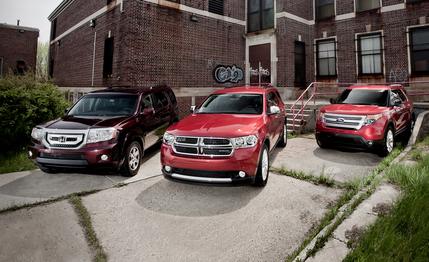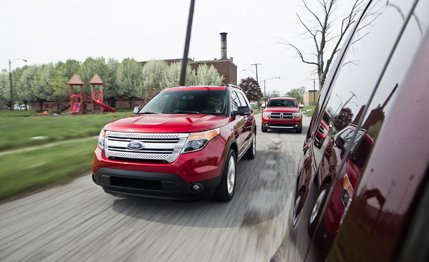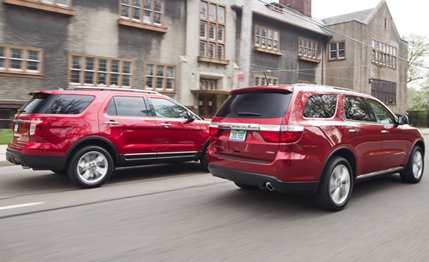
 Comparison Tests
Comparison Tests


When it comes to automotive function, it’s hard to beat the minivan. But, aside from a fussy two-year old, few things shout “Mommy!” quite as loudly. Minivans are about parenting, and moms and dads—as any teenager can attest—aren’t cool.
And yet, some parents cling desperately to the fantasy that they are as hip as Miles Davis. They might need a minivan, but they just can’t stand the silent judgments of society. Enter the alternative to the one-box kid hauler: the three-row SUV. We last visited this burgeoning segment in 2008, when we assembled six three-row non-minivans. The Honda Pilot emerged victorious by a slight margin over the Mazda CX-9. We praised the Pilot’s spacious eight-passenger interior, its eagerness to venture off-road, and its somewhat carlike handling. Since then, two all-new competitors have turned up in the car-pool lane.


From Ford comes the Explorer. Once a sales-topping SUV and the darling of suburbia (until it became branded a rolling, flipping, tire-tread-shedding menace), the Explorer is new from the rubber up. The traditional body-on-frame structure is gone, swapped for a slightly lighter unibody platform that also underpins the Flex and whose roots can be traced to Volvo. A V-8 is absent from the order books; the most powerful engine is a 290-hp, 3.5-liter V-6. For the fuel conscious, a turbocharged 2.0-liter four-cylinder with 237 horsepower is on its way. All-wheel drive is an option on V-6 models; otherwise, the Explorer is a front-drive machine.


Over at Dodge, the old-school body-on-frame Durango sat out Chrysler’s bankruptcy ugliness and, like the Explorer, has returned this year as a unibody “crossover” SUV. A product of parent company Chrysler’s now severed ties with Mercedes-Benz, the platform can count the Benz ML and the new Jeep Grand Cherokee as kin. Unlike its three-row competition gathered here, the Durango can still be had with a V-8—a very serious 360-hp, 5.7-liter Hemi. But this class is dominated by V-6 power, so for this test we recruited a Durango with the standard 290-hp, 3.6-liter V-6 (there’s also a Heat trim level, which increases V-6 power to 295). Unlike the Explorer, two-wheel-drive Durangos are rear-drive.
In the interest of determining which minivan alternative works best, we spent a few days and more than 300 miles driving these three vehicles, climbing in and out of second and third rows, and folding and unfolding seats. During our drive, we stopped for lunch at Win Schuler’s restaurant in Marshall, Michigan, where the spreadable and highly addictive Bar Scheeze was created. We brought back a large tub of the zesty cheese for our co-workers to enjoy, plus a new champ in the three-row-SUV class.

